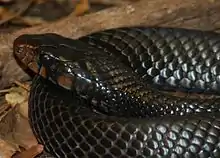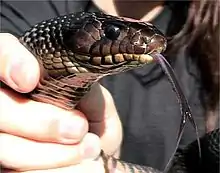Drymarchon
Drymarchon is a genus of large nonvenomous colubrid snakes, commonly known as indigo snakes or cribos,[3] found in the Southeastern United States, Central America, and South America. Reaching 3 m (9.8 ft) or more in length, they are among the world's largest colubrid snakes.
| Drymarchon | |
|---|---|
 | |
| Drymarchon couperi, eastern indigo snake | |
| Scientific classification | |
| Kingdom: | Animalia |
| Phylum: | Chordata |
| Class: | Reptilia |
| Order: | Squamata |
| Suborder: | Serpentes |
| Family: | Colubridae |
| Subfamily: | Colubrinae |
| Genus: | Drymarchon Fitzinger, 1843[1] |
| Species | |
|
See text. | |
| Synonyms[2] | |
| |
Description
Indigo snakes are large, robust snakes which can reach a total length (including tail) of over 3 m (9.8 ft). They have smooth dorsal scales, and several color variations, including a glossy blue-black color. This snake genus, Drymarchon, means "Lord of The Forest".
Behavior and diet
Indigo snakes are diurnal and actively forage for prey. They feed on a broad variety of small animals such as rodents, birds, lizards, frogs, toads, and other snakes, including rattlesnakes. They are not aggressive snakes and will only bite when threatened. Typical threat display includes hissing and shaking of its tail as a warning.
Species and subspecies
The genus Drymarchon was formerly considered to be a monotypic taxon formed by subspecies of D. corais. Currently the genus includes six distinct species recognized by ITIS:[4] One of the species has several subspecies which are recognized as being valid.
- Indigo snake, yellow-tailed indigo snake — Drymarchon corais (F. Boie, 1827)
- Falcon indigo snake — Drymarchon caudomaculatus Wüster, Yrausquin & Mijares-Urrutia, 2001[5]
- Eastern indigo snake — Drymarchon couperi (Holbrook, 1842)[6]
- Margarita indigo snake — Drymarchon margaritae Roze, 1959
- Middle American indigo snake — Drymarchon melanurus (A.M.C. Duméril, Bibron & A.H.A. Duméril, 1854)
- Black-tailed cribo — Drymarchon melanurus melanurus (A.M.C. Duméril, Bibron & A.H.A. Duméril, 1854)
- Texas indigo snake — Drymarchon melanurus erebennus (Cope, 1860)[7]
- Orizaba indigo snake — Drymarchon melanurus orizabensis (Dugès, 1905)
- Mexican red-tailed indigo snake — Drymarchon melanurus rubidus H.M. Smith, 1941
- Unicolor cribo — Drymarchon melanurus unicolor H.M. Smith, 1941
Nota bene: A binomial authority or a trinomial authority in parentheses indicates that the species or subspecies was originally described in a genus other than Drymarchon.
References
- Fitzinger L (1843). Systema Reptilium, Fasciculus Primus, Amblyglossae. Vienna: Braumüller & Seidel. 106 pp. + indices. (Drymarchon, new genus, p. 26). (in Latin).
- Wright, Albert Hazen; Wright, Anna Allen (1957). Handbook of Snakes of the United States and Canada. Ithaca and London: Comstock Publishing Associates, a division of Cornell University Press. 1,105 pp. (in 2 volumes) (Genus Drymarchon, p. 200).
- "Cribos and Indigo Snakes" (PDF). madisonherps.org. Retrieved 2018-10-21.
- "Drymarchon ". Integrated Taxonomic Information System. Retrieved 2011-02-06.
- Wüster, Wolfgang; Yrausquin, José Luís; Mijares-Urrutia, Abraham (2001). "A new species of indigo snake from north-western Venezuela (Serpentes: Colubridae: Drymarchon)" (PDF). Herpetological Journal. 11: 157–165. Archived from the original (PDF) on 2007-02-05. (Drymarchon caudomaculatus, new species).
- Hammerson GA (2007). "Drymarchon couperi ". IUCN Red List of Threatened Species. 2007: e.T63773A12714602. doi:10.2305/IUCN.UK.2007.RLTS.T63773A12714602.en.
- Lee J, Calderón Mandujano R, Lopez-Luna MA, Vasquez Díaz J, Quintero Díaz GE (2007). "Drymarchon melanurus". IUCN Red List of Threatened Species. 2007. Retrieved 8 February 2011.CS1 maint: ref=harv (link)
External links
| Wikimedia Commons has media related to Drymarchon. |

